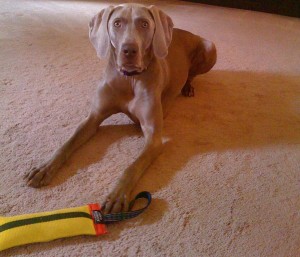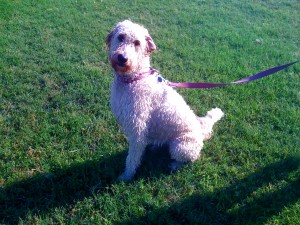Here’s a cute video of two golden litter mates!
New iPhone app -Dog and Puppy Shake – Fun Facts and Trainer Truths
21st Century Dogs – Dog and Puppy Club

Dog Puppy Behavior Training Help
How's Bentley Dog and Puppy and Behavior and Training and Help
Here’s a cute video of two golden litter mates!
New iPhone app -Dog and Puppy Shake – Fun Facts and Trainer Truths
21st Century Dogs – Dog and Puppy Club
 Sometimes we get so engrossed in stopping our dogs’ behaviors, we overlook the simple solutions. Friendly, jumping up on guests is the most common problem reported by my clients.
Sometimes we get so engrossed in stopping our dogs’ behaviors, we overlook the simple solutions. Friendly, jumping up on guests is the most common problem reported by my clients.
Many dogs calm down after a few minutes, so this solution is for those guys, the dogs that are too excited to obey during the first few minutes, but do relax after their initial exuberance has passed!
We’ve all read the same books and advice. Attach a leash, prevent the dog from mugging your guests. Teach the dog to sit politely for greetings. Yuk! How boring!
In theory that sounds like great advice. But in reality, many people do not have the skills, the time, or regular guests to use for practice. And some dogs are too darned excited to sit! I prefer to give these turbo dogs another active and exciting task (besides jumping up on guests).
Here’s my easy solution that will cost you under $15 and about 10 minutes to put into place. This works especially well for labrador and golden retrievers!
Try this jumping up solution with dogs that like toys, and are proud to prance with toys in their mouths.
Purchase a new toy. Dogs seem to really like fire hose material. The texture is a bit different and the fire hose is very durable. Amazon has a great selection. Here’s the best one I’ve found at the best price.
You’ll need to build a history of excitement and glee, and associate the toy with proud prancing, before you can use it in real life. You’ll do this when no visitors are nearby.
Give your dog the new toy. Chase, praise, cheer, clap your hands, make high pitched repetitive noises. Do whatever it takes to get your dog prancing or racing around the house with the new toy!
After 3 minutes of excitement, ask your dog to drop the toy and place the toy near your door. Wait an hour and then repeat the fire hose toy playtime. This time, you’ll label the game. Say something like, “Fire Hose” and then race to get the toy near the door. Give your dog the toy and cheer him on!
From now on, your dog only gets that particular toy when people visit your house. Say, “Fire Hose” and give your dog the toy the instant you open the door and invite the visitors inside your home. It’s very likely that your problem of “excited dog jumping on visitors” will be replaced with a display of prancing and running with the fire hose toy.
Happy Training!
Alan J Turner – How’s Bentley – Memphis TN
21st Century Canine Relationship Specialist
New iPhone app -Dog and Puppy Shake – Fun Facts and Trainer Truths
21st Century Dogs – Dog and Puppy Club
I use stay as a temporary command whenever I want Bentley to remain in one spot for a brief period.
This is useful if I drop or spill something and want to pick it up without being “mugged” or bothered by a curious dog.
When I ask Bentley to stay, I am saying, “Please remain in this location. I am going to leave or perform some task. I will come back to you and give you a reward for staying.”
When teaching stay, I never walk away and then call the dog to me. I always return to the dog and release him from the stay.
I teach stay in cycles. Each cycle I add a bit more movement or action. Once the dog learns the concept of stay, I add distractions. I might practice the same cycles with items in my hand, while waving my arms, clapping, dancing, etc.
Once the dog will stay for my distractions, I work with the dog and invite other people to play the role of distractions.
Before you begin training your dog, you’ll need to learn a bit about communication and motivation. Please visit the Dog Training Start Here Category. There you will learn about markers and rewards, two excellent topics for communicating and motivating! A prerequisite for “stay” is “Attention on Cue”. It doesn’t hurt if your dog already knows “Sit” too!
Cycle 1:
With the dog on a lead, I say “stay”, wait 1 second, and then push my open hand towards him – like a stop signal. Then I withdraw my hand.
I wait 2 seconds and then deliver the reward marker to release the dog, followed by a food treat.
Cycle 2:
With the dog on a lead, I say “stay”, wait 1 second, and then push my open hand towards him – like a stop signal. Then I withdraw my hand.
I take a couple of steps with each foot, but do not move forward or backward. I march in place. I stop moving my feet.
I wait 2 seconds and then deliver the reward marker to release the dog, followed by a food treat.
Cycle 3:
Same as cycle 2 except I might take a backward step and then return, or twist my upper body or shoulders just a bit.
I stop all body motions.
I wait 2 seconds and then deliver the reward marker to release the dog, followed by a food treat.
Following Cycles:
Each cycle I get a bit more creative with my actions or movements. I always return to the dog, pause 2 seconds and then release him by delivering the marker.
Troubleshooting Stay
Many people tell their dogs to stay and immediately turn and walk away. Naturally the dog follows. He has no clue what stay means. When this happens, people just repeat the sequence but say “Stay” a bit harsher, as if now the dog will understand.
The key to success is teaching in cycles. Add one small bit of motion during each cycle. If your dog does not stay, reduce the motion and try again.
It helps to have a particular goal in mind. For instance, teach your dog to stay when you drop a pencil and then pick it up. Each cycle will add a bit more of the motion involved in bending over and picking up an item.
Be patient, add small “pieces” of distractions and you will succeed!
If your dog follows you, herd him back to the beginning location, repeat the command and try again. This time use less motion. If your dog fails 2x in a row, make sure you succeed on the 3rd cycle. Perform an easy cycle with no distractions.
I never let my dog fail 3x in a row. THree failures in a row tell me that I am adding distractions above his current skill level.
 Some of my clients repeat a cue or command to their Memphis labrador retriever puppy or dog many times, either in efforts to get the behaviors, or to keep the behaviors. For example, many people repeat the word sit when their dogs don’t sit on the first command.
Some of my clients repeat a cue or command to their Memphis labrador retriever puppy or dog many times, either in efforts to get the behaviors, or to keep the behaviors. For example, many people repeat the word sit when their dogs don’t sit on the first command.
Saying stay…stay…stay… while walking away and extending your hand out like a stop signal is another common example.
I have a set of “loose” rules for repeating commands. Generally speaking, I use one technique with dogs that are learning or practicing. Another is for dogs that have learned and practiced a command (in a similar environment) and are not cooperating.
Sometimes it’s difficult to know if the dog is not cooperating or genuinely confused.
Unless I am certain that the dog can perform under the current circumstances, I always address the situation as if the dog is learning. I try to help the dog perform the behavior.
In other instances, I might treat the dog as if he is both learning and not cooperating.
Dogs Who are Learning, Practicing and Cooperating
Before I repeat the command, first I change something about my body language, the dog’s position, or both. Then I ask again. These position changes are quick, fluid and sometimes unnoticed by an observer. I may change position several times as I try to get a particular behavior.
Some of the adjustments involve only my positioning and body language. Others prompt the dog to change position.
For instance, suppose I ask for sit. If the dog doesn’t sit, I might lean towards the dog with my upper body or lead the dog a step or two to the left or right and try again.
If I am seated (when I ask the first time), I stand up. I might move a step closer to the dog, or take a step farther away, or bend forward, or tilt back, or square my shoulders, or kneel down, or whatever I feel might be helpful. After one or many of these small adjustments, I’ll repeat the command.
Some dogs need more help to get started.
With these guys, I’ll ask for “shake” or “touch” or whatever tricks or behaviors the dogs will perform. After the dogs perform, I ask for the initial behavior again.
When I do anything that causes a dog to move, I’m prompting cooperation.
The act of encouraging the dog to move creates a tension break, a sort of casual conversation. It gives the dog a chance to warm up to the whole cooperation idea!
Eliciting muscle movements primes the dog to perform other motion behaviors. It’s like pushing a car. Once you get the car rolling, it’s easier to keep it rolling and to steer it!
Dogs Who are not Cooperating
If I am working with a dog with all of these attributes, A) knows the behavior, B) can do the behavior in the current environment, C) has done the behavior in the current environment, I rarely repeat commands with only a position change.
Instead, I tell the dog that he or she has failed to cooperate and I am disappointed.
Here’s how I do it.
Suppose I ask for sit and the dog just looks at me. Instead of repeating the command, I turn and walk away. For the next 5-10 seconds, I ignore any attempts by the dog to get my attention. After this brief time out, I turn and face the dog and ask again. The dog quickly learns that I only ask one time!
Happy Training!
Alan J Turner – Companion Animal Behavior Counselor & Trainer, Canine Specialization
How’s Bentley – Private and Group Dog Obedience
Memphis, Collierville, Bartlett, Cordova, Germantown, Arlington, Jackson, Olive Branch,Oxford, MS, TN
 Raising a puppy and training a dog is a process, not an event. It’s not much different than raising a child (except in 3 years your puppy will be an adult dog). Suppose you hire me to come to your house and teach your child to be polite. I can tell the kid which words to use ,what they mean, and when to use them. That teaching session is an event. But later, I will not be with your child to praise her for polite gestures, or to remind her to be polite. That is a continual process.
Raising a puppy and training a dog is a process, not an event. It’s not much different than raising a child (except in 3 years your puppy will be an adult dog). Suppose you hire me to come to your house and teach your child to be polite. I can tell the kid which words to use ,what they mean, and when to use them. That teaching session is an event. But later, I will not be with your child to praise her for polite gestures, or to remind her to be polite. That is a continual process.
I have potential clients who would pay me whatever to come to their homes and train their dogs. I would gladly accept these lucrative offers if I believed the dogs would be responsive to them afterwards. Some dogs will obey without a lot of practice. But these are rarely the dogs that prompt people to seek out a trainer.
Don’t get me wrong, I can teach your chocolate labrador retriever commands for sit, down,come, stay, go-to-place, leave-it, et cetera much quicker than their owners. Initially teaching dogs to obey without distractions is the easy part. Those initial lessons are events.
Your dog is always learning, even when you are not holding practice sessions. Every interaction throughout the day teaches your puppy or dog something. If you are unaware of how your responses throughout the day shape your dog’s behavior, no amount of event training by me will override your daily mistakes.
Dogs learn by repetition. Practicing while adding distractions, in very controlled training sessions, and working with the dogs, every day, in real life situations, is a time consuming process.
If you want to begin a training program for your dog, please visit the START HERE category.
Happy Training!
Alan J Turner – Companion Animal Behavior Counselor & Trainer, Canine Specialization
How’s Bentley – Private and Group Dog Obedience
Memphis, Collierville, Bartlett, Cordova, Germantown TN
 Lucy was retrieving like a full blooded Labrador Retriever today! The 1.5 year old female Goldendoodle was quite excited to be splashing and running in shallow flood waters of the Mississippi River. She was absolutely on target and would not come back without the treasured stick!
Lucy was retrieving like a full blooded Labrador Retriever today! The 1.5 year old female Goldendoodle was quite excited to be splashing and running in shallow flood waters of the Mississippi River. She was absolutely on target and would not come back without the treasured stick!
Lucy quickly made friends, and competed with two other dogs, but Lucy always came back with the stick! GO LUCY!
I work with Goldendoodles and/or Labradoodles every week. They are a popular and excellent mix! The retriever genes fuel the gentle, cooperative, “Oooookay” attitude of a Labrador or Golden Retriever. The Standard Poodle genes might say, “Why should I?, What’s in it for me?” They are excellent dogs if you meet their exercise and stimulation needs AND provide basic obedience training!
I took these pictures of the Mississippi River in Memphis TN. The river is the second longest in the USA and the largest by volume.
Today in Memphis TN, May 17th, 2009, the river is above the 34 foot flood stage. It is expected to crest at 34.5 feet. At 35 feet, most of the land within the mainline levee system will be flooded. Yikes! The National Weather Service issued a flood watch.
Alan J Turner, Companion Animal Behavior Counselor & Trainer, Canine Specialization
Private and Group Dog Training in Memphis, TN
Owner: How’s Bentley